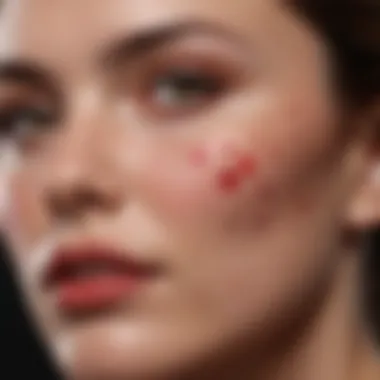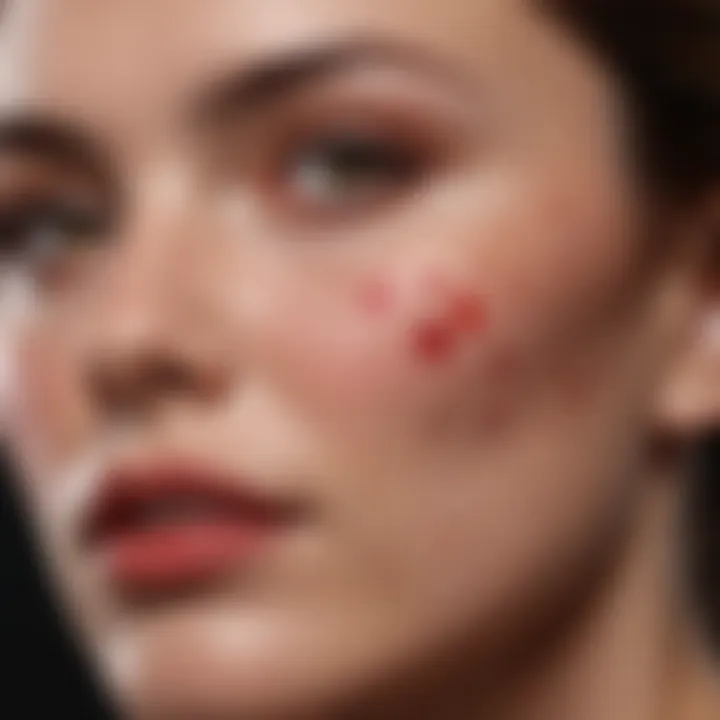Understanding the Causes of Red Spots on Your Face


Intro
Red spots on the face can cause significant distress for many individuals. These spots may vary in color, shape, and size, prompting questions about their origins and implications. Understanding the causes of these skin irregularities is crucial in addressing potential health concerns. Various factors, including allergies, skin conditions, environmental influences, and lifestyle choices, contribute to the appearance of facial red spots. This article aims to provide a comprehensive overview of the many possible causes of these bothersome marks.
Facial redness can arise from both common conditions, such as acne and rosacea, as well as rare ailments that may require specialized medical attention. The physiological processes behind these conditions play a key role in how skin manifests symptoms, making it essential to grasp their underlying mechanisms. By exploring these factors, individuals can recognize the significance of their symptoms and consider appropriate responses or treatments.
As we probe deeper into the intricate world of skin health, we will cover a variety of topics including detailed examinations of conditions that cause red spots and how they can be effectively managed.
Foreword
The appearance of red spots on the face can be distressing for many individuals. Understanding the causes of these marks is vital for maintaining skin health and overall well-being. Individuals may experience these spots due to a variety of factors ranging from skin conditions to environmental influences. Recognizing the contributing elements can guide effective management and treatment.
For women of all ages, facial skin is particularly sensitive and prone to various changes. This sensitivity can heighten anxiety regarding skin appearance. The importance of addressing red spots lies not just in aesthetics but also in health considerations.
Key Elements to Consider
- Variety of Causes: Red spots can arise from allergies, acne, eczema, rosacea, and more. Each cause has distinct characteristics that require tailored approaches.
- Physiological Processes: The skin’s response to factors such as irritants, inflammation, or infection can lead to red markings. Understanding these processes provides insight into prevention and treatment.
- Impact of Lifestyle: Daily habits including diet, hydration, and stress levels play significant roles in skin health. By focusing on these lifestyle factors, individuals can enhance their skin's resilience.
Understanding these factors allows readers to make informed decisions about their skin care, recognize warning signs, and seek appropriate medical advice when necessary. A comprehensive overview will empower individuals, reducing anxiety associated with unexpected skin changes.
The Skin’s Structure and Function
Understanding the structure and function of the skin is essential when exploring the causes of red spots on the face. The skin serves multiple roles, acting as the body’s first line of defense against pathogens and environmental stressors. Its integrity influences not just physical appearance but also overall health. Red spots can be a symptom of underlying issues within the skin itself or related to systemic conditions affecting the skin's health.
Overview of Skin Layers
The human skin consists of three primary layers: the epidermis, dermis, and subcutaneous tissue.
- Epidermis: This is the outermost layer. It acts as a barrier, protecting the body from external threats. Additionally, it contains skin cells that continuously regenerate. When the epidermis undergoes stress or damage, it can lead to redness and irritation, making it significant in assessing red spots.
- Dermis: Located beneath the epidermis, the dermis contains connective tissue, blood vessels, and nerve endings. This layer provides structural support and nourishes the epidermis. Conditions affecting the dermis, such as inflammation or infection, can result in visibility of red spots.
- Subcutaneous tissue: This is the deepest layer, composed mainly of fat and connective tissues. It helps insulate the body and absorb shocks. While less directly involved in skin appearance, changes here can influence the overall health and function of the skin.
Understanding these layers helps in recognizing how problems in the skin can lead to symptoms like red spots.
Role of the Immune System in Skin Health
The skin is not just a physical barrier; it plays a critical role in the immune system. Special immune cells are present in the skin, particularly in the epidermis, to protect against infections and allergies. When the skin encounters an allergen or pathogen, these immune cells react, often leading to inflammation. This inflammation can manifest as red spots or rashes on the skin.
A robust immune response is vital for maintaining skin health. However, an overactive immune response can lead to conditions like eczema and psoriasis, which are characterized by redness and irritation. Thus, understanding the interaction between the skin and the immune system is crucial in diagnosing and treating red spots.
“The skin is an active organ, reflecting both external conditions and internal health.”
Common Causes of Red Spots
Understanding the common causes of red spots on the face is essential for recognizing potential health issues or skin conditions. Red spots can result from various factors, such as allergies, acne, or skin disorders like rosacea and eczema. Identifying these causes helps individuals make informed decisions about treatment and management, leading to improved skin health. Moreover, recognizing specific triggers allows for proactive measures to prevent further outbreaks, contributing to long-term well-being.
Allergic Reactions
Types of Allergens
Allergic reactions often manifest as red spots on the skin. Common allergens include substances like pollen, certain foods, or skincare products. The body's immune system responds to these allergens, causing inflammation and redness. Distinguishing the type of allergen is crucial to managing these reactions effectively. For instance, environmental allergens, such as dust mites or pet dander, often require different strategies compared to food allergens. The unique aspect of allergens is that they provoke varying responses in individuals. One person's mild reaction may prompt severe symptoms in another. Awareness of personal allergens is vital for avoiding exposure and preventing flare-ups.
Symptoms of Allergic Reactions
The symptoms of allergic reactions can range from mild redness to itchy welts. Common signs include swelling, burning sensations, or even blistering in severe cases. Recognizing these symptoms as part of a broader allergic response is important. Immediate identification can lead to prompt treatment, minimizing discomfort. The key trait of these symptoms is their sudden onset following exposure to an allergen. This distinctive feature can guide individuals to seek out potential triggers in their environment. Understanding the particular symptoms associated with allergies empowers individuals to take swift action, whether that entails seeking medical attention or managing with over-the-counter remedies.
Acne and Acne-Related Conditions
Types of Acne
Acne is another prevalent cause of red spots on the face. Various types of acne can appear as pustules, papules, or cysts. Each type is characterized by specific features and may require different treatment approaches. The inflammation surrounding these lesions contributes to the redness seen on the skin. For instance, pustular acne generates whiteheads or yellowish lesions, while cystic acne can cause larger, painful bumps. Understanding these types enables individuals to better address their conditions. Treating acne effectively often involves a combination of topical and oral medications tailored to the acne type. However, it is essential to consult a dermatologist for personalized treatment strategies.


Impact of Hormones
Hormonal changes significantly impact skin conditions like acne. Fluctuations in hormone levels can lead to increased oil production, consequently clogging pores and causing breakouts. This directly links hormonal activity to the appearance of red spots on the face. Women, especially during menstrual cycles or pregnancy, often experience such hormonal fluctuations. Awareness of hormonal influences helps in anticipating acne outbreaks. Implementing lifestyle modifications or treatments targeted at balancing hormones can improve skin conditions.
Rosacea
Symptoms of Rosacea
Rosacea is a chronic skin condition that often leads to prominent red spots and flushing. Symptoms can include visible blood vessels, persistent redness, and in some cases, small bumps resembling acne. Recognizing these symptoms is fundamental as they differ from standard acne or allergic reactions. The distinctive facial flushing often sets rosacea apart from other conditions. Many individuals with rosacea experience flare-ups triggered by elements such as spicy foods, temperature changes, or stress. Early identification of these symptoms allows for the adoption of effective management strategies.
Triggers and Management
Understanding the triggers of rosacea is crucial for effective management. Common triggers include sun exposure, hot beverages, and certain cosmetic products. By recognizing these triggers, individuals can take proactive steps to minimize flare-ups. Effective management may involve both topical treatments and lifestyle adjustments, such as using sunscreen and avoiding certain foods. The unique aspect of managing rosacea lies in its persistent nature, and adopting a consistent daily skincare regimen is essential to keeping symptoms at bay.
Eczema
Common Forms of Eczema
Eczema comprises various conditions that can lead to red, inflamed patches on the skin. The most common forms include atopic dermatitis and contact dermatitis. Each variant presents unique symptoms but shares the characteristic of redness and irritation. Recognizing the specific type of eczema can assist in determining the most effective treatment. For example, atopic dermatitis often appears alongside other allergies, while contact dermatitis results from direct contact with an irritant or allergen. Understanding common eczema forms aids in crafting personalized treatment plans.
Examining Triggers
Triggers play a significant role in exacerbating eczema symptoms. These can range from environmental factors like pollen to specific fabrics that cause irritation. Identifying personal triggers is fundamental to preventing flare-ups. Many individuals benefit from keeping a symptom diary to map out when and where outbreaks occur. This focused examination can lead to tailored recommendations for skincare routines and lifestyle adjustments to reduce irritation. Recognizing these trigger factors aids in managing eczema more effectively, allowing for healthier skin.
Less Common Causes of Red Spots
Understanding the less common causes of red spots on your face is crucial for a comprehensive approach to skin health. While many people can identify typical conditions like acne or allergies, less common causes can also lead to significant skin changes. Recognizing these can inform treatment decisions and help in timely diagnosis. Many individuals are unaware that skin appearances can signal underlying health issues, and addressing these can prevent further complications.
Psoriasis
Psoriasis is a chronic autoimmune condition that often presents as red, scaly patches on the skin. It can appear on various areas, including the face. The skin cells in affected areas grow too quickly, resulting in a buildup that forms these red spots. This condition is not contagious and tends to go through cycles; flare-ups are common and can be triggered by various factors such as stress, infections, or changes in weather.
Managing psoriasis often requires a multifaceted approach, incorporating topical treatments and lifestyle adjustments. Awareness is essential because many people may confuse psoriasis with other skin issues. Proper diagnosis is key to receiving the appropriate treatment.
Fungal Infections
Fungal infections can lead to red spots on the face, often mistaken for other skin conditions. They occur when fungi invade the skin, an event that can happen more easily if the skin is compromised. Common types include tinea faciei, which can cause round, red patches. Symptoms can include itching, peeling, or scaling.
To effectively treat fungal infections, antifungal medications are usually prescribed. It's important to recognize that while these infections are not usually serious, they can persist and become bothersome if not addressed properly. Maintaining good hygiene and reducing moisture exposure can help prevent these infections.
Viral Infections
Viral infections can also manifest through red spots on the face. Conditions like herpes simplex or varicella-zoster can cause noticeable skin changes. Herpes simplex, for instance, can lead to painful blisters that turn into red spots once they burst.
In many cases, viral infections require antiviral medications for effective management. It's crucial to consult with a healthcare professional for an accurate diagnosis. Understanding the specific viral condition can lead to better management and fewer outbreaks.
Seeking professional advice is a vital step if you notice persistent or severe red spots on your face, as early diagnosis can lead to more effective treatments.
Environmental Factors Influencing Skin Appearance
Environmental factors play a critical role in the overall health and appearance of the skin. Understanding these influences is essential for addressing the causes of red spots on the face. The skin acts as a barrier against external elements, but it is not immune to the damaging effects of pollution, UV radiation, and different aggressors in the environment. By knowing how these factors can affect your skin, you can take steps to mitigate their impact and improve your complexion.
Pollution and Skin Aging
Pollution is a significant concern for urban dwellers and has a direct impact on skin health. Airborne pollutants, such as particulate matter and toxic chemicals, can penetrate the skin and lead to oxidative stress. This stress can damage skin cells and accelerate the aging process, which may contribute to the appearance of red spots.
- Effects of Pollution:
- Increases free radicals in the skin.
- Contributes to inflammation, making skin look redder.
- May lead to conditions such as eczema and acne.
A study highlighted in the Journal of Investigative Dermatology showed a correlation between high pollution levels and increased incidences of skin irritation. Therefore, maintaining a consistent skincare regimen that includes antioxidants can assist in combating these effects. Additionally, facial masks that can cleanse and protect skin from pollutants should be considered.


Sun Exposure and Its Effects
Sun exposure is another critical factor that influences skin appearance. UV rays can trigger inflammatory responses in the skin, which can manifest as red spots. While some sunlight exposure is necessary for vitamin D synthesis, overexposure can lead to numerous skin issues, including premature aging and an increased risk of skin cancer.
- Key Points about Sun Exposure:
- UVA and UVB rays damage collagen and elastin.
- Can cause sunburn, leading to red spots and peeling skin.
- Alters pigmentation, possibly creating uneven skin tones.
It is essential to protect the skin from harmful UV rays by using broad-spectrum sunscreen, wearing protective clothing, and limiting sun exposure during peak hours. Moreover, incorporating after-sun products can soothe and repair the skin, minimizing damage from UV radiation.
"A comprehensive approach to skin care includes considering environmental factors such as pollution and sun exposure, which can significantly worsen skin health."
By understanding these environmental factors and their impacts on skin health, individuals can take proactive steps to safeguard their skin, ultimately reducing the occurrence of red spots and enhancing overall appearance.
Lifestyle Factors Affecting Skin Health
Lifestyle factors play a significant role in skin health and the appearance of red spots on the face. Understanding this importance goes beyond merely applying cream or ointment; it includes a holistic approach to daily life choices. The skin is an organ that reflects overall health, and the choices made in diet, stress management, and hydration can influence its condition.
A comprehensive look at these lifestyle factors can yield insights not just into the formation of red spots but also how they can be mitigated or prevented. Small adjustments in daily habits can lead to considerable improvements in skin appearance and health over time. Here, we will discuss three critical areas of lifestyle that impact skin well-being – diet, stress, and hydration.
Diet and Skin Condition
Diet has a direct effect on skin health. The food consumed provides the necessary vitamins and minerals that the body requires to function optimally. Certain nutrients are particularly beneficial for maintaining skin clarity and reducing inflammation.
- Vitamin C: Found in citrus fruits, it helps with collagen production, crucial for skin elasticity.
- Omega-3 Fatty Acids: Present in fish like salmon, they help in maintaining the skin's lipid barrier, reducing dryness.
- Antioxidants: Berries and nuts are rich in antioxidants that protect the skin from oxidative stress and promote healing.
It is best to avoid excess sugar and processed foods, as they can lead to inflammation and may increase the risk of skin conditions like acne and eczema. Maintaining a balanced diet supports not just the skin but overall physical health, making it a vital consideration in reducing the appearance of red spots.
Stress Management and Skin Health
Stress is an unavoidable part of life, but its management can have a profound effect on skin conditions. High stress can trigger hormonal changes in the body, which might lead to increased oil production and, subsequently, acne breakouts or flare-ups of existing skin conditions.
To mitigate stress, practices such as yoga, meditation, and regular physical activity can be beneficial. These methods help to lower cortisol levels, the hormone associated with stress, promoting a more balanced emotional and physical state. Individuals might find it helpful to incorporate activities they enjoy, such as reading or spending time with friends, to further alleviate stress and support skin health.
"Stress management is not just a mental exercise; it can significantly affect your skin's clarity and appearance."
Hydration and Its Importance
Hydration is fundamental in maintaining skin health. Water consumption affects the skin’s moisture levels and overall function. Dehydrated skin can appear flakier, dull, and more prone to irritation.
- Daily Water Intake: Aim for at least eight glasses of water per day, adjusting based on activity level and climate.
- Moisturizing Products: Use moisturizers that contain hyaluronic acid, which helps attract and retain moisture in the skin.
By prioritizing adequate hydration, individuals can ensure that their skin maintains its natural barrier function, minimizing red spots and promoting a smoother complexion.
Diagnosis and Evaluation
Diagnosis and evaluation play a crucial role in understanding the nature of red spots on the face. It is vital because accurate identification can significantly influence treatment options. Red spots may be symptomatic of underlying health conditions ranging from benign to severe. By assessing their characteristics, a dermatologist can differentiate between various skin disorders and recommend appropriate interventions.
The evaluation process seeks not only to identify the condition but also to determine its potential causes. Factors such as duration, location, and associated symptoms provide essential clues. Furthermore, diagnosis can lead to early recognition of conditions, which may prevent progressive issues later on. Therefore, paying attention to both the physical attributes of red spots and individual medical history becomes fundamental in skin health management.
When to Seek Professional Help
Determining when to seek professional help is imperative for anyone experiencing facial red spots. Ignoring persistent or worsening symptoms can lead to complications. It's time to consult a healthcare professional if:
- The redness does not improve after a few days.
- There are changes in the texture of the skin or the appearance of new spots.
- Other symptoms develop, such as itching, pain, or swelling.
- The redness is associated with systemic symptoms, like fever or fatigue.
Early intervention can prevent the condition from worsening, ensuring better treatment outcomes. The sooner a qualified professional is consulted, the more likely it is to diagnose and address the underlying issue effectively.
Common Diagnostic Tools


Healthcare providers utilize a variety of diagnostic tools to assess red spots on the face. Some of the common methods include:
- Visual Inspection: Dermatoscopic examination allows for a closer look at the skin's surface and can help identify specific characteristics of the lesions.
- Medical History Review: Understanding prior skin conditions, allergies, and overall health assists in forming a comprehensive picture.
- Skin Biopsy: In some cases, a small sample of affected skin may be taken for laboratory analysis. This helps to clarify the diagnosis and rule out serious conditions, such as skin cancer.
- Patch Testing: If an allergic reaction is suspected, patch tests can reveal specific allergens causing the red spots.
It is advisable to maintain an open dialogue with your healthcare provider regarding any skin changes.
Employing these tools enables healthcare specialists to provide tailored treatment recommendations that effectively address the red spots and their underlying causes.
Treatment Options for Red Spots
Understanding treatment options for red spots on the face is essential for anyone dealing with skin concerns. These spots may denote underlying issues, ranging from temporary irritations to chronic conditions. Identifying the right intervention can mitigate discomfort and enhance skin appearance.
Moreover, treatment can vary based on the cause of red spots. Factors like skin type, severity of the condition, and lifestyle choices play a crucial role in determining the most effective approach. By exploring topical treatments, oral medications, and lifestyle modifications, individuals can craft a comprehensive treatment plan.
Topical Treatments
Topical treatments are often the first line of defense against red spots. They apply directly to the skin and can target specific symptoms or underlying conditions. Products containing ingredients such as hydrocortisone, salicylic acid, or benzoyl peroxide can be beneficial.
- Hydrocortisone: This is a mild corticosteroid that reduces inflammation and can relieve redness and swelling.
- Salicylic Acid: Effective in treating acne-related issues, salicylic acid helps to unclog pores and reduce the formation of new spots.
- Benzoyl Peroxide: Known for its antibacterial properties, this treatment targets acne-causing bacteria, helping to soothe existing spots.
Many cosmetic products are also formulated with soothing agents, such as aloe vera or chamomile, which can alleviate irritation and redness. It is important to patch test these products before regular use to avoid adverse reactions.
Oral Medications
In more severe cases, oral medications may be required to tackle red spots effectively. These medications are usually prescribed by a healthcare provider, as they address the issue from within the body.
- Antibiotics: Often used for inflammatory skin conditions like acne or rosacea, oral antibiotics can reduce bacteria and inflammation.
- Retinoids: These are vitamin A derivatives that promote cell turnover and prevent clogged pores. They can be effective for managing chronic acne and some forms of dermatitis.
- Antihistamines: If allergies are the cause of the red spots, antihistamines can help to reduce histamine response, alleviating symptoms.
Consulting a dermatologist is crucial to ensure appropriate medication and dosage to minimize side effects and enhance effectiveness.
Lifestyle Modifications
Making certain lifestyle changes can significantly influence skin health and help in managing red spots. These modifications are often complementary to topical and oral treatments and focus on overall skin wellness.
- Balanced Diet: A diet rich in vitamins, antioxidants, and healthy fats can promote skin health. Consider incorporating foods like leafy greens, berries, and nuts.
- Hydration: Keeping the body hydrated is essential for maintaining skin elasticity and preventing dryness, which can exacerbate red spots.
- Stress Management: High stress levels can lead to skin flare-ups. Techniques like yoga, meditation, or regular exercise can be beneficial.
Preventive Measures
Taking preventive measures is an essential strategy in maintaining skin health. Red spots can often surface as a sign of irritation or underlying health issues. Hence, understanding preventive actions can minimize the risk of developing these concerns. A sturdy regimen not only helps in avoiding red spots but also enhances overall skin quality and appearance.
Daily Skin Care Routine
A daily skin care routine serves as the foundation for preventing skin issues, including red spots. Elements of such a routine typically include cleaning, moisturizing, and exfoliating.
- Cleansing: Choose a gentle cleanser suitable for your skin type. Cleansing your face twice a day can help remove dirt and impurities that may cause irritation.
- Moisturizing: Proper hydration is crucial. Use a lightweight, non-comedogenic moisturizer to keep your skin hydrated without clogging pores.
- Exfoliating: Regular exfoliation, about once or twice a week, can prevent dead skin buildup. Opt for a mild exfoliant to avoid irritating your skin.
Additionally, include serums or treatments that cater to specific concerns, such as inflammation or hydration. For women of all ages, this routine can become a moment of self-care, creating a positive relationship with their skin.
Sun Protection Strategies
Protecting your skin from sun exposure is another critical preventive measure. Damage from ultraviolet rays can lead to red spots and even more severe skin issues like skin cancer. Effective sun protection strategies include:
- Sunscreen Application: Use a broad-spectrum sunscreen with an SPF of at least 30 every day, even when it's cloudy. Reapply every two hours if you are outdoors.
- Wearing Protective Clothing: Light long-sleeved shirts and wide-brimmed hats can provide additional protection against sunlight.
- Seeking Shade: Whenever possible, seek shade, especially during peak sun hours between 10 am and 4 pm.
Consistent sun protection not only prevents red spots but also helps in maintaining skin elasticity and preventing premature aging.
By implementing these preventive measures, individuals can significantly reduce the risk of developing red spots and maintain healthy skin. This commitment to skin health reflects a proactive approach, allowing for greater control over one’s appearance and self-care.
The End
In summarizing the complex topic of red spots on the face, it becomes clear that understanding the underlying causes is crucial for both diagnosis and treatment. Red spots can signal a range of issues, from benign conditions to more serious health concerns. Recognizing this is the first step towards appropriate action.
The article has explored various factors contributing to the appearance of red spots, including allergic reactions, skin conditions like acne and rosacea, as well as environmental and lifestyle influences. Each of these aspects plays an important role and needs to be considered.
Understanding the interplay between these factors empowers individuals to take control of their skin health.
A key element emphasized is the value of seeking professional help when necessary. Early diagnosis can aid in effective treatment, preventing potential complications that could arise from neglecting these symptoms. Furthermore, adopting a proactive approach—such as maintaining a proper skincare routine and addressing lifestyle habits—can significantly improve overall skin appearance.



